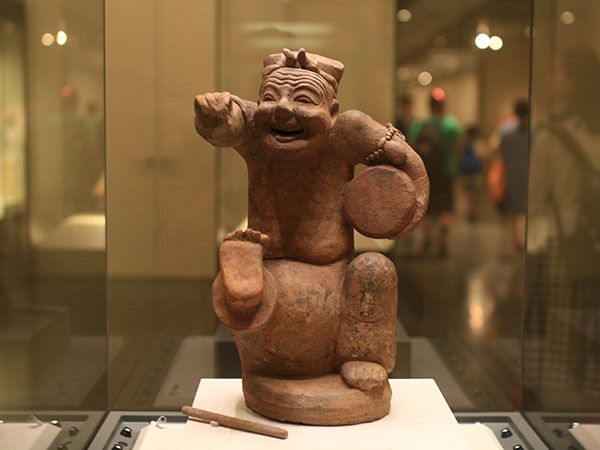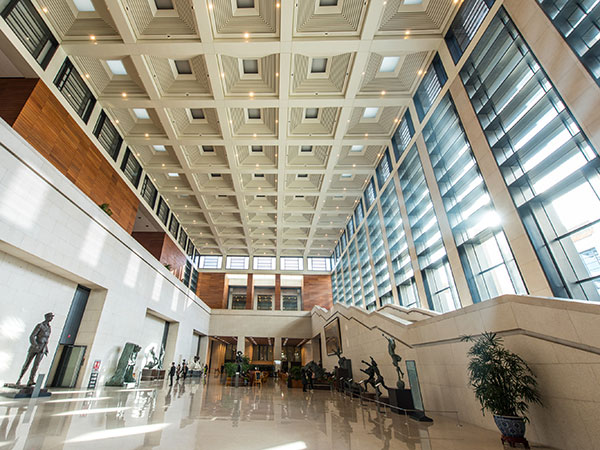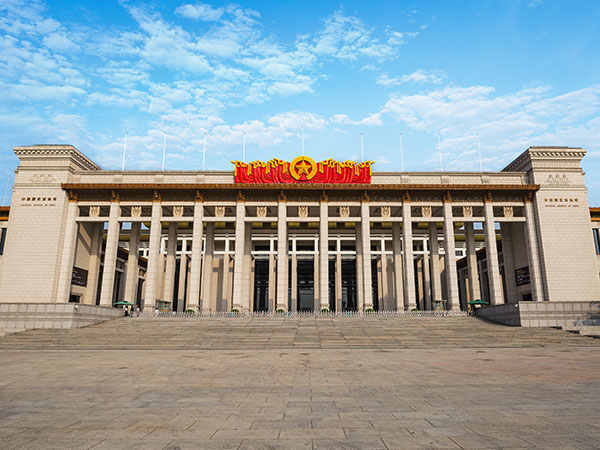National Museum of China is located the downtown of Beijing city, at the east side of Tiananmen Square and south side of Changan Avenue, opposite with the Great Hall of the People. It is one of the largest museums in the world, playing an important role in displaying systematically Chinese culture, cultivating national spirit, leading the development of the cultural relics and museum field.
National Museum of China covers a total gross floor area of nearly 200,000 square meters, being the largest single building area of the museum world. The number of collections in the museum is more than 120 million pieces, being the richest museums with the largest number of collections. There are a total of 48 exhibition halls and there are exhibitions showing the collections and Chinese culture often. In 2012, there were 5.37 million people visited to this museum, being one of the world’s most frequently visited museums.
Its basic functions are cultural relics and artworks collection, history and art research, public education, exhibition display and cultural communication.
Being the largest museum in the world with first class facilities and capabilities, there are Café offering various cakes, coffee, and hot and cold drinks, Tea Room, Gift Shop offering exclusive gifts and replicas, souvenirs, luxury items including jewellery, tea set, and silk scarves, and Bookshop with books about ancient Chinese history, art history, archaeology, and collections
History of National Museum of China
This museum is an integrated national museum founded in February 2003, based on the merging of two previous museums, namely the National Museum of Chinese History which was founded in 1912 tasked to safeguard China’s larger historical legacy and National Museum of Chinese Revolution which was founded in 1950 to preserve the legacy of the 1949 revolution. The building was one of ten famous architectures built in 1959 to mark the 10th anniversary of the founding of the People’s Republic.
The predecessor of the Museum of Chinese History is the Beijing History Museum built in 1912 and was opened to the public in October 1926. Upon the founding of the People’s Republic of China on Oct 1st , 1949, the museum was renamed the Beijing Museum of History, only to be renamed once again as the National Museum of Chinese History in 1959.
The predecessor of the Museum of Chinese Revolution was the Preparatory Office of the National Revolution Museum that was founded in March, 1950, and was given its current name ten years later. In August of 1959, with the completion of new building at east side of Tiananmen Square that housed both museums. In September, 1969, The National Museum of Chinese History and the National Museum of Chinese Revolution merged. It was named the National Museum of Chinese Revolution and History. In early 198, the two museums returned to their own separate entities but later in February, 2003, the merging of the two museums took place and the National Museum of China was established.
Collections in the Museum
The museum, covering Chinese history from the Yuanmou Man of 1.7 million years ago to the end of the Qing Dynasty (the last imperial dynasty), has a permanent collection of 1,050,000 items, of which many precious and rare artifacts not to be found in museums anywhere else in China or the rest of the world.
Jar showing a stork with a fish and a stone axe
This belongs to the Yangshao Neolithic Culture. The white pigment has been pressed on to form the pictures of a stork, stone axe and fish. The stork’s eye, the fish and sections of the axe are depicted with black outlines. The stork stands upright holding a large fish in its mouth, while to the right is a stone axe bound to a wooden handle.
Basin with a fish pattern with a human face
This is a treasure of the Neolithic. It was made from fine red clay. It has a wide lip and on the inside, black painted decorations of two fish and two opposing faces. The faces are circular with arch-shaped black areas on the forehead. On the right side, there is possibly a local tradition. The straight nose and the eyes depicted by thin straight lines give it a serene appearance.
Houmuwu square cauldron (ding)
This piece, which was called Simuwu, is a rectangular vessel. It has a protruding rim and thick square lip with two large upright arched handles, one of which has been replaced. There are shallow flanges on the face and corners of the body. The cauldron has straight sides, four hollow cylindrical feet and a deep belly and a flat base. The top and bottom of the body bears an animal face design with a coiled tail.
There are other masterpieces exhibited in the museum, such as dragon and tiger vessel (zun) and square vessel (fang zun) with four rams made in late Shang (1300–1046 BC), jade dragon made in Neolithic, Hongshan Culture(6000-5000 BC), Guojizibai water vessel (pan) made in late Western Zhou (c. 9th century – 771 BC), gold and silver inlay cloud-patterned rhinoceros vessel (zun) etc.
How to Get to National Museum of China
• By Subway: Visitors should take Subway Line 1 and get off at Tian’an Men East Station; or take Subway Line 2 and get off at Qianmen Station
• By bus
Tian’an Men East Station, Routes: 1, 2, 10, 20, 37, 52, 59, 82, 99, 120, 126, 203 (night), 205 (night), 210 (night), 728, Special 1, Special 2.
QianMen Station, Routes: 5, 17, 20, 22, 48, 59, 66, 69, 71, 82, 120, 126, 301, 626, 646, 690, 692, 729
Tian’an Men Square East Station, Routes: 2, 5, 20, 22, 120, 126, 203(night), 210(night), special1, special2
Note:
You can get a free ticket from the Ticket Office at the West Gate by showing your valid ID (passport).
Food and drinks will be inspected to be brought in.
Please do not touch the objects on display.
Luggage shall be deposited after security check before visiting.



